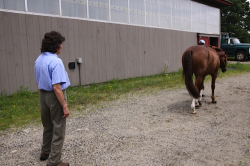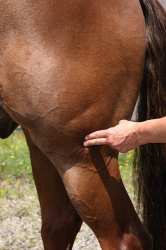|
Reported Problem:
A client called me to look at her horse
because he was scuffing his left hind toe and had a loss of power in
the same hind leg. When I watched him walk in a straight line away
from me he was scuffing his toe and carrying his left hind leg
slightly to the outside of his body. He was also delayed in bringing
the entire leg forward and under his body.
Interpretation of Gait Analysis at Walk:
 My first thoughts were to assume if this problem in
motion was of a muscular nature then it appeared to be related to
the lower end of the Biceps Femoris which is the lower hamstring.
The lower end of the hamstring basically flexes the stifle and
extends the hip. My first thoughts were to assume if this problem in
motion was of a muscular nature then it appeared to be related to
the lower end of the Biceps Femoris which is the lower hamstring.
The lower end of the hamstring basically flexes the stifle and
extends the hip.
Breakdown of Muscular Problem:
All muscles contract and release. They only
pull. It is the release process of the muscle that is effected by
muscle tightness. When thinking about this particular muscle
problem, one needs to break down the motions created by this section
of the hamstring.
1.When the lower end of the Biceps Femoris
flexes the stifle, meaning, bending the knee (stifle), then if it is
tight, it will not release properly to extend the knee (stifle). If
the muscle does not release easily, then when bringing the hind leg
forward the horse will scuff his toe because the leg must extend in
one phase of the stride. His toe will scuff because he is not
completely free to easily extend the leg forward at the walk.
2. If it is the job of the muscle to extend
the hip, then the same principle of the release process applies. It
is the release process that is effected by muscle tightness. If the
hip can extend, but the hamstring is tight, then flexion of the hip
will be harder to do because the muscle cannot release fully to
bring the hind leg forward.
 Solution: Solution:
I palpated all of
the major muscles of the horse and found a significant spasm at the
lower end of the hamstring behind the stifle muscles on the left
side. I applied direct pressure, cross fiber friction and
compressions to this area all of the techniques of the Wilson
Meagher Method of Sportsmassage. I released the spasm and general
muscle tightness. I asked the client to jog the horse away from me
in hand to be certain the muscle tightness was reflective of a
deeper structural problem. Then I had the client walk the horse in a
straight line and he was no longer scuffing his toe and he was able
to swing his leg forward under his body with ease.
It is the ease of motion that gives a horse
their balance, coordination, reflexes, endurance and safety. Simple
muscle tightness can compromise these critical requirements for good
motion and performance.
|

